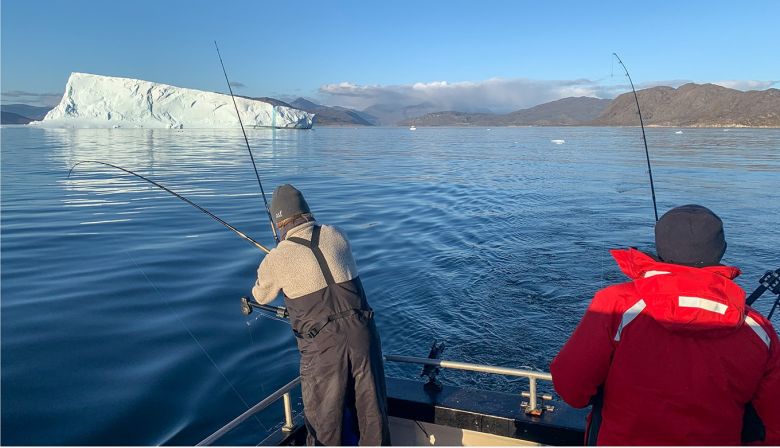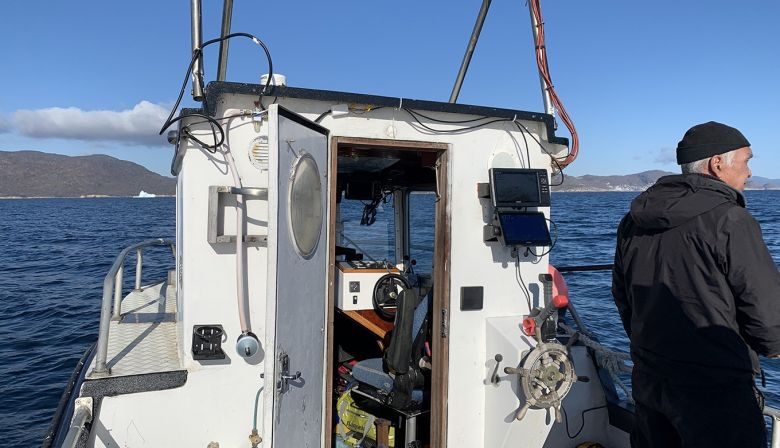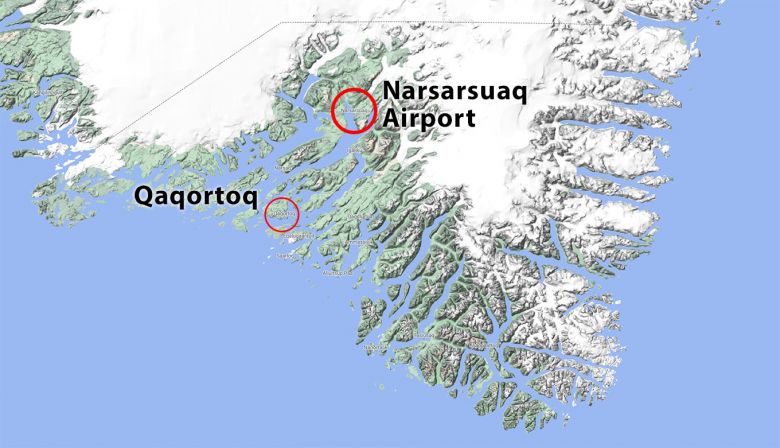
Subscribe & stay up-to-date with ASF


Updated Oct. 4, 2021
“We have had very good weather over the past week,” says Jonathan Carr, ASF Vice-president of Research and Environment.
“Most days begin with a bit of a breeze, but generally it fades out and then we have had calm seas plus the blue skies. Plus this year there are numerous Atlantic salmon in the waters off Qaqortoq.”
The project did not start off as auspiciously he said. There were a few days of rain, and that led into some falls of snow, before the weather and sea state turned around in the biologists’ favour.
“We came with 70 of the satellite tags, and so far we have been able to attach 68 of them by end of day Oct. 3. We are extremely pleased with the way this has come together this year,” said Jonathan.
The satellite tags consist of sophisticated digital recording units, attached to a small balloon, with a short aerial on top.
The Atlantic salmon are fished by multiple rods, each single hooked, and reeled in. The success this year plus glassy water surface most days has kept stress on the fish to a minimum.
Each is brought aboard the boat, run by a knowledgable Qaqortoq fisherman, and they are temporarily settled in coolers with ocean water, which is around 2 C. A scale sample is taken that can identify both the history of the Atlantic salmon, and give information on the origin of the fish.
Some of the Atlantic salmon will be those originating in rivers of the Republic of Ireland and the United Kingdom. But it is expected that the larger share will be returning to rivers in eastern Canada and Maine.
The ASF biologists attach the satellite tag transmitters with efficiency, to reduce stress on the Atlantic salmon.
First a saddle of inert resin is attached, bracketing the dorsal fin. Then the satellite tag is attached to the saddle. The attachment to the salmon is programmed to release after a defined number of months.
The Atlantic salmon is then carefully returned to the water.
When the satellite transmitter “pops off,” it will float to the ocean surface, and begin transmitting. Satellites in space passing overhead will collect the data, and with analysis can provide the route taken by the salmon, as well as the history of its cruising depth, whether at the surface or as deep as 800 m. or more, as ASF has discovered from previous work. There remains a mystery in the reason the Atlantic salmon spend days in the black depths far from the sunlight. Speculation includes the pursuit of prey, feeding on small fish and juvenile squid or perhaps some crustaceans. Potentially they are keeping away from ocean predators.
The tracking program has collaboration with the U.S. National Oceanic and Atmospheric Administration (NOAA) and with Canada’s Department of Fisheries and Oceans (DFO). But this year only ASF biologists were able to get into the field in Greenland.
ASF’s ability to develop safe but practical working methods that also take into consideration Covid-19 has allowed its researchers to be effective when governmental organizations fall short.
Jonathan Carr is extremely optimistic on the success this year.
“So far we have attached 68 of the 70 satellite pop-off tags, and by the time we are finished, it is possible the remaining two units may also be deployed.”
“This is the largest set of satellite pop-off transmitter tags ever deployed in one operation,” says Jonathan.

The complicated travel doesn’t end with the winding up of the field season in early October. The need to address Covid-19 requirements continues to make international travel a challenge.
ASF Heather Perry will be returning to St. Andrews in the next few days.
“From Qaqortoq I will return to the airport at Narsarsuaq. From there I will be flying to Amsterdam. I don’t need to get a Covid-19 test in Greenland to get there.
” But while in Amsterdam I need to get a virus test to continue the trip home to North America. The testing for Covid-19 is all part of the travel arrangements one needs to do to undertake this successful Greenland research.”
Jonathan Carr in the last few days travelled north to the Greenland capital at Nuuk for meetings. From there he will be fly through Copenhagen, Denmark, and onward to get back to his home in St. George, NB. In addition to the Covid-19 testing, the airlines appear nearly overwhelmed with the situation, in part with travellers changing plans.
The Atlantic salmon at-sea tracking research is vitally important in understanding where the high mortality at sea for Atlantic salmon is taking place.
It is increasingly clear that Atlantic salmon do not follow a single migration route, either to the Greenland feeding grounds, or back home.
The tracking research in Greenland waters gives biologists the best chance of understanding the issues with the return phase of the great Atlantic salmon migration to and from rivers in Maine, Atlantic Canada and Quebec.
With so many transmitters attached to Atlantic salmon this year, it is hoped the results will produce a large important data set of results, especially once the interpretation is completed.
